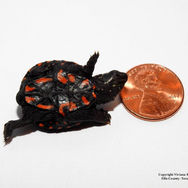
MISSISSIPPI MUD TURTLE (Kinosternon subrubrum hippocrepis), (GRAY, 1856)
IDENTIFICATION: 4-4.75 inches (7.5-12.1 cm). The brown to nearly black carapace is broad and smooth in adults. While the carapace of babies has a wrinkled texture. The plastron is yellowish-brown and may be immaculate or bear some dark markings of brown or black. Newly hatched babies will have a bright reddish orange plastron and similarly colored spots along the marginal scutes of the carapace. These fade away in about a year. A double hinge is present on the plastron. The posterior portion of the plastron is notched on males. Among female specimens the notch is absent or reduced. The fleshy areas of the neck, limbs and tail are gray to olive brown. The head is gray with a mottling of olive to brownish-gray. A pair of light colored stripes are present on either side of the head. The snout is pointed and squarish from a lateral profile. The jaws are usually lighter in color than the head and accented with dark specks.An inhabitant of slow moving streams, lakes, lagoons, rivers and swamps with soft bottoms and aquatic vegetation. This species can also be found in undisturbed marshes with brackish water. The Mississippi mud turtle is primarily aquatic but ventures onto land during the morning and on overcast days just before and after rain showers. Depending upon the locality some populations (especially the southern ones) may remain active throughout most of the year.
BEHAVIOR AND ECOLOGY: Breeding usually takes place from March to May and females usually lay their eggs in October. A clutch of eggs is deposited into a nest dug out of sandy soil or leaf litter and can consist of 1-6 oval brittle shelled eggs that measuring 1 inch (2.54 cm) in length. Sometimes the nest are laid a considerable distance (200 m) from the nearest body of water.
One adult female specimen is known to have lived in captivity for 38 years.

Counties indicated by gray represent specimens records that are present in other range maps but questionable and the identification of the specimens needs to be confirmed. Due to locality, these could be misidentified common musk turtles (Stenotherus odoratus).











